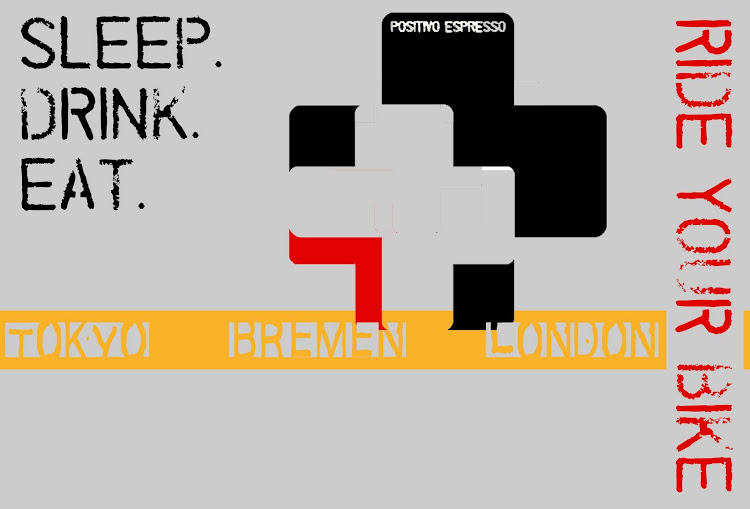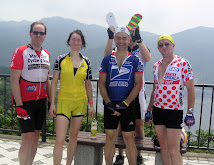And then there were concerns about the nuclear power plants in Fukushima, not so close to Tokyo, but not so far either, with a lot of confusion in the hours following an explosion that blew the roof and walls completely off of the building that houses (housed?) reactor #1. The huge explosion was visible via some media outlets (I saw one broadcast that had been posted to youtube and linked from U.S. aggregators like Business Insider), while on Japanese TV I could not find any footage, and the government reported that the "roof had collapsed" while at the same time asking people to evacuate within a 20 km radius. I think "roof had been blown to smithereens" would be a bit more accurate, even if this did not ultimately coincide with a major radiation release (and who really knows, yet?).
So I put off any ride until Sunday, awoke, quickly checked the news (no meaningful news updates) and decided to head to the west, as usual, and even further away from the disaster zone. I was hoping to get over Sasago Pass and then try Kamihikawa, or maybe head up the first part of Odarumi and along the Crystal Line, inspecting for quake-related damage. But I planned to go at a leisurely pace, as my legs were so stiff when I awoke that I could barely walk -- the result of descending 29 flights of stairs in my road cycling shoes on Friday end of the day to get out of my office building (note to self -- next time, walk down in your normal shoes and change at the bottom, even if it requires bring them home in the rucksack).
What I found was, well, normal. There were significantly reduced volumes of traffic as compared to a typical Sunday, but otherwise nothing out of the ordinary. Life goes on. And the further west of Tokyo, the more normal things are. The main disruption that I found was at the 7-11 in Takao, where there was no 2-liter private label bottled water available, though everything else could be had. Further away from Tokyo, at the 7-11 past Otsuki, even the 2 liter bottled water is available. And baseball practice is proceeding as usual, along the Tamagawa and further out west.
 |
| The Chuo Line runs normally between Fujino and Uenohara, no damage to houses, roads, bridges or train lines. |
 |
| The Katsuragawa flows normally toward Otsuki, from Tsuru, on a late winter/early Spring day. Observe the non-landslide on that steep hill along the western (right side) bank of the river. |
 |
| At Otsuki Hatsukari Elementary School ... Baseball practice must go on! |
I headed up the old road toward Sasago Pass, but was quickly met by snow and ice on the road in the shade -- a bit of a surprise given the lack of visible snow on the lower hills to that point, and the warm temperatures (by now over 10 degrees celsius and climbing to the mid- or upper-teens).
I dismounted and walked through the patches of ice, since I remembered that the road would soon climb along a sunny, much more exposed slope, where I expected any snow would have long since melted. This worked well at the lower elevations and until I got much closer to the pass, when I began to run into some deeper drifts across the road, even on the sunny slopes. I pushed my bike through a few of these.
I gave up, 50-75 meters or so elevation below the tunnel, when I reached a patch of snow that continued around the corner and as far as I could see beyond, and also as I realized that the opposite slope of Sasago is mostly shaded and so probably in far worse shape.
After a quick trip back toward Otsuki, I made the left term at Magi and started the climb up to O-Toge. The Sasago climb on the old road starts at 700 meters elevation, whereas the Magi traffic light is below 450 meters, so at least I would get some climbing before encountering snow. And the climb is all on the South slope of the mountain. I made it up to the gate, and around the next corner, before I found the first stretch that would require dismounting. Realizing that this was the first of many and that I still had 500 meters of elevation gain ahead, I turned around and headed for home.
 |
| The O-toge gate, approximately 975 meters elevation. |
 |
| O-Toge Southern approach at 1000 meters elevation. |
 |
| Another undamaged farm house on a smooth road -- Magi, on the climb toward O-Toge, about 75 km west of Tokyo. |
Map:
http://ridewithgps.com/trips/190306/full.gif
Elevation Profile:
http://ridewithgps.com/photos/snapshots/trip-histogram-190306.jpg
And today, from my office a photo of a few of the many buildings in central Tokyo that did not fall down on Friday:
















1 comment:
David, thanks for posting these peaceful and somewhat comforting pictures you took along yesterday's inspection tour. The contrast with all the recent images of destruction is surreal.
I was also cycling yesterday, same direction over Wada and noticed considerably less cyclists than on usual sunny sundays. Once home, I immediately took a shower - longer than usual although I'm sure the exposure was minimal and probably less than the amount of radioactivity we get on a typical transcontinental flight.
This morning's commute to work was horrible; I could barely breathe and thought my ribs were getting crushed on the Keio Line.
Tomorrow I might commute with my cyclocross - I guess I should hold onto this precious bike just a little longer!
Post a Comment